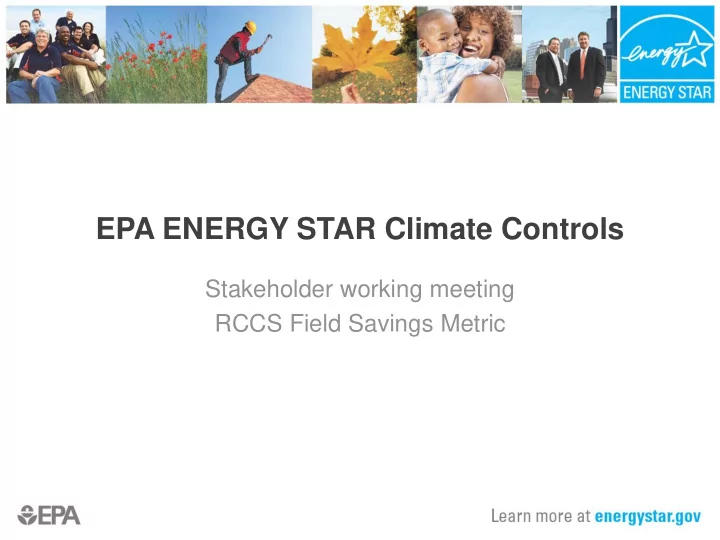

EPA ENERGY STAR Climate Controls Stakeholder working meeting RCCS Field Savings Metric
Agenda • Quick run through algorithm, clarifying questions • Feedback on algorithm and method, discussion • Capture new ideas • Next steps working together • Parking lot 1
Representative data Daily total run time vs. daily average outdoor temp (should this be Δ T = T out – T in instead?) 2
Representative data Daily total run time vs. daily average outdoor temp 3
Representative data Daily total run time vs. daily average outdoor temp 4
Curve and scatter affected by • Temperature settings in home • Equipment capacity • Home characteristics (insulation, sealing, etc.) • Day/night temperature differences (climate) • Level and type of activity in the home • Schedule of activity in the home • Solar gain • Other heating sources 5
HDD • Consider using HDD and CDD to eliminate the problem of fitting a piecewise linear curve • Also provides a check: intercept should be zero • If derived from Δ T vs run time, balance temp is Δ T at which no heating is called for; can be negative. 6
Basic algorithm • Derive model • Use model to develop counter-factual baseline annual run time based on different temperature settings • Compare to actual annual run time • Metric per home: relative run time reduction in heating and cooling ∆𝑆𝑈 ∆𝑆𝑈 ℎ 𝑑 𝐷𝑇 = 𝐼𝑇 = 𝑆𝑈 𝑑 𝑏𝑑𝑢𝑣𝑏𝑚 𝑆𝑈 ℎ 𝑏𝑑𝑢𝑣𝑏𝑚 7
Detailed step: developing model • Need – First guess for heating balance temperature – Total heating run time for each day in the year (When does a day start? Does it matter?) – Average outdoor temperature for each day in the year • Iterate: – Calculate HDD for each day based on current guess of balance temp – Linear fit, daily run time vs. daily HDD – Check intercept & quality of fit – Is it good enough? If not, choose a new guess for balance temp • Once the fit is good enough, record the slope and balance temp 8
Detailed step: counter-factual baseline temperature settings • For first iteration of metric, assuming baseline is constant at a comfort temperature • Use 90 th percentile of indoor temperature for heating comfort temperature (different for each home) • Use 10 th percentile of indoor temperature for cooling comfort temperature • Likely to overestimate absolute savings • Possibly improvement is to use regional average indoor temperatures, which may more realistically reflect existing set back/set up behavior. However, we are not aware that this data is broadly available 9
90 th percentile looks like this “A data driven framework for comparing residential thermostat energy performance”. July 2014, 10 Bryan Urban and Kurt Roth, Fraunhofer Institute, co-developed with Nest.
Detailed step: using model to derive heating run time reduction • Estimate the difference between baseline HDD and actual HDD as the difference between the average actual indoor temperature and the baseline indoor temperature. • Calculate the run times: – ΔRT = sum over all days of (α h • 1 day •(T base heat – T heat )) – RT check = sum over all days of (α h • HDD actual ) – RT actual = sum over all time periods of heating equipment run time • Calculate Q = RT actual – RT check which should be close to zero • Calculate HS = ΔRT/RT actual 11
Intended process moving forward • EPA will release code open source code for calculating our current idea for a metric • Providers will run the code on the data that they have available • Providers will report results to EPA (or ICF) • EPA will publish all results together anonymously so that all stakeholders can see where they stack up according to the metric 12
Sample of publicly released data Data provided to EPA CS HS CU σ σ σ mean 90th 10th mean 90th 10th mean 90th 10th Provider 1 Provider 2 Provider 3 13
Discussion • Ratio estimator instead of linear fit – Average y over average x and divide – forces slope through zero, calculate mean square error. Weights the days with higher degree days more heavily, because the intercept is forced towards zero – Use average daily temps to get DD, or use sum of hourly readings? • Δ T model might be better than HDD? – Start the HDD calculation with ∆T rather than with absolute outside T, the run a ratio estimator – ∆T vs run time is a linear fit 14
Discussion • Baseline – pros and cons of the 90 th percentile – To be addressed in detail on 1/30/15 • How to handle heat pumps – Also not addressed in detail 14
Agreed upon actions • EPA will capture the various options to calculate the model of run time for each home, and send around to stakeholders as a meeting report. • EPA will post slides and meeting report to climate controls development web page. Stakeholders may also request to have it sent to them. • Stakeholders with data will run algorithms on it, and be ready to talk about results and issues on 2/13/15. • Discussion two weeks from today will focus on baselines; stakeholders are invited to come prepared with thoughts and/or references. 15
Parking lot • Will providers use this method to make savings claims? • Verification and gaming the system? • Modulating system thermostats not eligible – market disadvantage? • Does the customer base bias the metric results, aside from the qualities of the products? 16
Contact Information Abigail Daken EPA ENERGY STAR Program 202-343-9375 daken.abigail@epa.gov Doug Frazee ICF International 443-333-9267 dfrazee@icfi.com
Recommend
More recommend